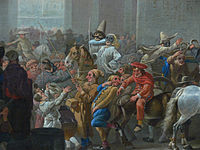Fastelavn
Fastelavn is the name for Carnival in the historically Lutheran nations of Denmark, Sweden, Norway, Iceland and the Faroe islands which is either the Sunday or Monday before Ash Wednesday. Fastelavn is related to Roman Catholic tradition of Carnival in the days before Lent, but after Denmark became a Protestant nation, the festival became adopted certain distinctives. This holiday occurs the week before the Christian penitential season of Lent, culminating on Shrove Tuesday, the day before Ash Wednesday, the first day of Lent.[1] In it, children dress up in costumes and gathering treats for the Fastelavn feast. The holiday is generally considered to be a time for children's fun and family games.
Etymology
The term Fastelavn comes from Old Danish fastelaghen, which was a borrowing of the Middle Low German vastel-avent, meaning "fast-evening", or the day before Lent.[2] The word has cognates in other mostly Germanic languages, including Limburgish Vastelaovend, Dutch Vastenavond, Scots Fastens-een and Estonian Vastlapäev.
Festivities
Some towns in Denmark are renowned for their large Fastelavn festivities and parades. Traditional events include slå katten af tønden ("hit the cat out of the barrel"), which is somewhat similar to using a piñata. The Danes use a wooden barrel, which is full of candy and sometimes oranges and has the image of a cat on it. Historically there was a real black cat in the barrel, and beating the barrel was superstitiously considered a safeguard against evil. After the candy pours out, the game continues until the entire barrel is broken. The one who knocks down the bottom of the barrel (making all the candy spill out) becomes kattedronning ("queen of cats"); the one who knocks down the last piece of the barrel becomes kattekonge ("king of cats").

In Denmark and Norway a popular baked good associated with the day is Fastelavnsbolle (lit. "Fastelavns buns", also known in English as "shrovetide bun" or "lenten bun"), a round sweet roll usually covered with icing and sometimes filled with whipped cream. A popular children's song in Denmark is:
|
Shrovetide is my name,
|
Similar buns are eaten in other northern European countries, for example the Swedish Semla. Ísafjörður is the only town in Iceland that celebrates Fastelavn on the same day as the Nordic countries, the day being known as Maskadagur ("mask-day").
There seem to be some small local traditions which are closer to the carnival traditions of other countries, including Ash Wednesday, Carnival parades, Pancake Tuesday and eating special food after Ash Wednesday, but they are not particular to Danish culture.
Another popular custom (especially among the children) is the "fastelavnsris", with which children ritually flog their parents to wake them up on the morning of Fastelavns Sunday (Quinquagesima).
Fastelavnsris have many shapes and forms and differ from area to area. In some areas they are bunches of twigs, usually from fruit trees and preferably with buds. Those are often decorated with feathers, egg-shells, storks and little figures of babies. In other areas, they are a bent willow-branch, shaped like an ankh and wound with crepe paper that has frizzles cut with scissors. Both varieties may be decorated with candy as well.
The custom was known in 18th century in Denmark and it has several roots. It may[citation needed] originate from an old fertility ritual, which has been absorbed into Christianity. The more serious one is that after the reformation, particularly pious people used to flog their children[citation needed] on Good Friday to remind them of the sufferings of Christ on the cross. A similar custom is mentioned in the book "Frauenzimmerlexicon", published in 1715 in Leipzig (Germany), which describes how bachelors and virgins "bid each other goodmorning" by flogging each other and spreading ashes on each other. This custom is also known in Denmark.
Earlier, it was mainly the young women and the infertile who were flogged. It was also common that a young man would carry his "fastelavnsris" and gently strike at young women he met on the street. Later it became the children's special right to flog their parents on this day. In any case, the reward given for the flogging would be a fastelavnsbolle.
In Norway, students having seen celebrations in Paris introduced Carnival processions, masked balls and Carnival balls to Christiana in the 1840s and 1850s. From 1863, the artist federation kunstnerforeningen held annual Carnival balls in the old freemasons lodge, which inspired Johan Svendsens compositions "Norsk Kunstnerkarneval" and "Karneval in Paris". The following year, Svendsens Festpolonaise was written for the opening procession of the Carnival ball. Edvard Grieg also attended the Carnival, and wrote "aus dem Karneval" (folkelivsbilleder Op. 19). After the Rococo Hall at Grand Hotel opened in 1894, annual balls in the Carnival season were arranged until the hall was destroyed in a fire in 1957. Since 1988, the student organization Tårnseilerne have produced annual masquerade balls in Oslo in the historical renovated freemasons lodge in the Carnival tradition, with masks, costumes and processions after attending an opera performance. The Carnival season also includes Fastelavens søndag (with cream buns) and fastelavensris with decorated branches.
See also
References
- ^ Ruprecht, Tony (14 December 2010). Toronto's Many Faces. Dundurn. p. 115. ISBN 9781459718043.
Fastelavn, held the week before Lent, is the Danish Mardi Gras. This even takes place at the Danish Lutheran Church and at Sunset Villa.
- ^ "Fastelavn", Ordbog over het danske sprog, 1922.

